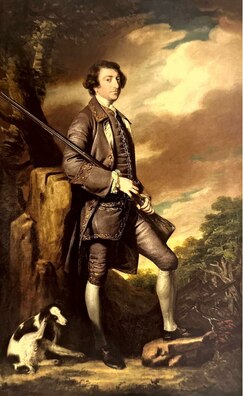Philip Eyre Gell

Philip Eyre Gell (1723–1795) of Hopton Hall near Wirksworth, Derbyshire, was a wealthy lead-mining aristocrat.[1]
Philip Eyre Gell was the son of Isabella, co-heir to the Jessop family of Broom Hall, Sheffield, and John Eyre, and grandson of Catherine Gell of Hopton Hall.[2] Philip's father assumed the surname Gell after inheriting the Gell family fortune in 1732, via his mother Catherine Gell, daughter of Sir John Gell, 2nd Baronet, and sister of 3rd baronet, Sir Philip Gell who had died in 1719 without a direct heir. When John Eyre died in 1739, the Hopton Hall estate, and Gell name, passed to son Philip Eyre, as eldest of seven children, which also included brother Admiral John Gell.
The family's fortune was founded on the local lead industry, through ownership of the lead tithes in the mines of Bakewell, Hope and Tideswell.[3] Gell is known for building the road between his lead-mining interests at Hopton and a new smelter at Cromford, naming the route Via Gellia as a nod to his family's unfounded claim of descent from the Romans.[4][5] He was High Sheriff of Derbyshire in 1755.[3] In 1777 textile entrepreneur Richard Arkwright leased a corn mill from Gell and converted it to spin cotton, using his water frame. It was the first cotton mill in the world to use a steam engine.[6]

Gell was married relatively late, when aged 50, to the poet Dorothy Milnes (daughter and co-heir of William Milnes of Aldercar Park), in 1774, with her parents' consent as she was 16.[7][8]
Dorothy Gell had her portrait painted by Joseph Wright of Derby and was part of ‘Wright’s set.’ Another of Wright’s sitters, Edward Becher Leacroft, dedicated a collection of poetry to Wright’s group, including Dorothy Gell.[9]
Philip Gell was educated at Pembroke College, Cambridge, to which he was admitted in 1741. He went on the Grand Tour to Italy in 1744 and remained there until 1747, visiting Padua, Venice, Naples and Rome. In Venice he is recorded as having attended a dinner given by Lord Holderness for the Society of Dilettanti, on 12 February 1745. After his return he became a member of the Society of Dilettanti in 1748.[10]
When Philip Eyre Gell died in 1795 he left the Hopton estate to eldest son Philip Gell MP (1775–1842). His second son was renowned antiquarian Sir William Gell.[5] Philip was succeeded by daughter Isabella, who died in 1878, thus ending the Gell line.
An archive of documents from the Gell family of Hopton Hall is held by the Derbyshire Record Office.[3]
Portrait of Philip Gell by Sir Joshua Reynolds
[edit]Completed in about 1763, Portrait of Philip Gell by Sir Joshua Reynolds is considered to be one of his greatest works.[11]
References
[edit]- ^ "GELL of Hopton,Derby". Archived from the original on 24 October 2019. Retrieved 29 June 2020.
- ^ John Burke, John Bernard Burke A genealogical and heraldic history of the extinct and dormant baronetcies
- ^ a b c "D258/10/86/62 – Gell of Hopton Hall". Derbyshire Record Office. Retrieved 20 January 2021.
- ^ "Hopton". Derbyshire Heritage. Retrieved 20 September 2021.
- ^ a b "WIRKSWORTH-Parish Records 1608-1899-Hopton Hall Auction". www.wirksworth.org.uk. Retrieved 2 July 2020.
- ^ Fitton, R. S. (1989), The Arkwrights: spinners of fortune, Manchester: Manchester University Press, p. 57, ISBN 978-0-7190-2646-1
- ^ Derbyshire Church of England Parish Registers, Derbyshire Record Office, Matlock, Derbyshire, England.
- ^ Glover, Stephen (1831). "The History and Gazetteer of the County of Derby: Drawn up from Actual Observation, and from the Best Authorities; Containing a Variety of Geological, Mineralogical, Commercial and Statistical Information".
- ^ Joseph Wright of Derby : Bath and beyond / Amina Wright, London : Philip Wilson/The Holburne Museum, [2014]
- ^ Important Old Master and British Pictures, Evening Sale, 5 July 2007, p130.
- ^ EK Waterhouse, Reynolds, London 1973 p39.
